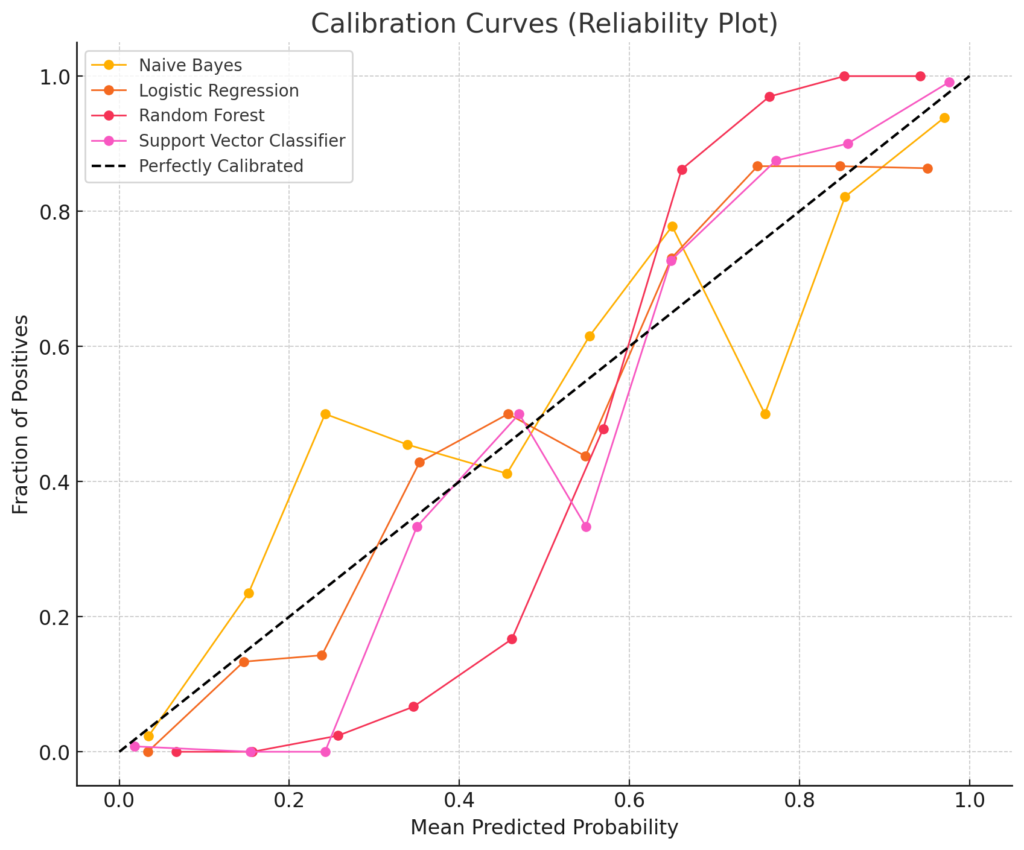Calibration curves are specifically used for classification models. The primary goal of a calibration curve is to evaluate the reliability of the predicted probabilities in a classification task. A calibration curve checks how well predicted probabilities align with the actual observed frequencies (e.g., when a model predicts 70% probability of being positive, we expect about 70% of such instances to actually be positive).
In applications like medical diagnosis or risk assessment, you want the predicted probabilities to be accurate. For instance, if a model says there’s an 80% chance of a disease, you want that probability to reflect reality.
# Re-import necessary libraries after the code reset
import numpy as np
import matplotlib.pyplot as plt
from sklearn.datasets import make_classification
from sklearn.model_selection import train_test_split
from sklearn.naive_bayes import GaussianNB
from sklearn.linear_model import LogisticRegression
from sklearn.ensemble import RandomForestClassifier
from sklearn.svm import SVC
from sklearn.calibration import calibration_curve
# Create synthetic dataset for binary classification
X, y = make_classification(n_samples=1000, n_features=20, n_informative=10, n_redundant=5, random_state=42)
# n_informative = 10 means that 10 of out 20 features are useful and have impact on Y
# n_redundant= 5 means that 5 out of 20 features are linear combination of other features and add collinearity
# Split data into training and testing sets
X_train, X_test, y_train, y_test = train_test_split(X, y, test_size=0.3, random_state=42)
# Define classifiers
classifiers = {
'Naive Bayes': GaussianNB(),
'Logistic Regression': LogisticRegression(max_iter=1000),
'Random Forest': RandomForestClassifier(n_estimators=100),
'Support Vector Classifier': SVC(probability=True)
}
# Plot calibration curves
plt.figure(figsize=(10, 8))
# Loop through classifiers and plot calibration curves
for name, clf in classifiers.items():
# Fit the classifier
clf.fit(X_train, y_train)
# Predict probabilities or decision function
if hasattr(clf, "predict_proba"):
y_prob = clf.predict_proba(X_test)[:, 1]
else:
y_prob = clf.decision_function(X_test)
y_prob = (y_prob - y_prob.min()) / (y_prob.max() - y_prob.min()) # scale to [0, 1] for plotting
# Calculate calibration curve
fraction_of_positives, mean_predicted_value = calibration_curve(y_test, y_prob, n_bins=10)
# Plot the calibration curve
plt.plot(mean_predicted_value, fraction_of_positives, marker='o', linewidth=1, label=name)
# Plot a perfectly calibrated reference line
plt.plot([0, 1], [0, 1], linestyle='--', color='black', label='Perfectly Calibrated')
# Configure plot
plt.xlabel('Mean Predicted Probability')
plt.ylabel('Fraction of Positives')
plt.title('Calibration Curves (Reliability Plot)')
plt.legend()
plt.grid(True)
plt.show()

